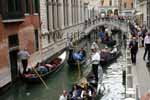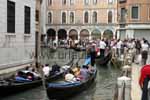A Gondola Trip through the Channels of Venice
The Gondolieri and their Gondolas: The Real Emblem of Venice

The gondolieri and their gondolas are so distinctive for Venice that I would like to dedicate an extra page to them. People might argue about the decision if a gondola trip is a must during a visit of Venice or not. But one cannot miss the several hundred black showpieces while having a walk and during the rush hours the gondolas are so busy that there are even queues at the gondola stations in order to get a free gondola for half an hour.
Gondola Trips in Venice
If somewhere in the world it is spoken about Venice, one does not hear first famous words as the Piazza San Marco or the Basilica. People rather associate Venice with the gondolas and the small waterways. The black gondolas and their gondoliers are the real figurehead of the city.
Thus, who wonders about the fact that for many visitors of Venezia, a gondola trip is the highlight of a city tour? Once, there where thousands of gondoliers; today, some few hundreds are left that paddle for a lot of money the tourists through the channels of the city and show them one or two sightseeings.

Up to six people can get into a gondola, whereby only two can sit really comfortable. There are several landing stages for the gondolas, from which one can start the gondola tour. During the city walks, one inevitably repeatedely passes the gondola ports, where the rudder masters promote their services. But also amidst the city one repeatedely comes across to some gondolas on some small bridges that can be rented immediately. I do not know any more how many times we have been appealed by the gondoliers with a free gondola during our walks, but I guess it happened each half an hour. "Gondole, Gondola service" the gondoliers call in order to gain new passengers.
The prices for the gondola trips are exorbitant and is absolutely disproportionate to the service that the gondoliers provide. If one pays 60 € for half an hour, one was already lucky to get such a good offer, but most of the times, the prices are clearly higher. And they are not fixed prices at all. I have noticed the following: during the first approaching, one gets an offer that is absolutely exaggerated; in the course of the conversation the price partly decreases to a maximum of two thirds of the original price. Who should prohibit the gondoliers to offer first a high price and then decrease it during the negotiation?
 We talked several times to the gondolieri and got always first the high price and afterwards a lower price offered. If one then still refuses the offer and distances oneself slowly and pensively, one can be sure that a gondoliere walks behind one and gives a better offer. One finally came out as an interested client who just thought the price is a little too high. We talked several times to the gondolieri and got always first the high price and afterwards a lower price offered. If one then still refuses the offer and distances oneself slowly and pensively, one can be sure that a gondoliere walks behind one and gives a better offer. One finally came out as an interested client who just thought the price is a little too high.
While many times, the initial prices where over 120 € for a three quarter of an hour, by this way, the prices partly decreased up to 70 €, whereby I also consider this price to be exaggerated.
 And another tip: a gondola trip is best done in the early forenoon when the gondolieris and the waterways are not busy yet. Then, on one hand, the prices are a little lower and on the other hand the waterways are free. During the rush hours, the narrow channels are partly so crowded that one really has to struggle through with the gondola; many times, one is caught up in a traffic jam and navigates during the agreed half an hour a much more shorter stretch than planned, if there is a question of navigating at all. And another tip: a gondola trip is best done in the early forenoon when the gondolieris and the waterways are not busy yet. Then, on one hand, the prices are a little lower and on the other hand the waterways are free. During the rush hours, the narrow channels are partly so crowded that one really has to struggle through with the gondola; many times, one is caught up in a traffic jam and navigates during the agreed half an hour a much more shorter stretch than planned, if there is a question of navigating at all.
There are also, by the way, some romantic round trips in Venice in the dawn and at night. Then, the gondoliere puts a small candle or a lamp on the bow and paddles unhurriedly through the waterways of the city. At nights, the channels are not busy and one can unhurriedly drift around. But a romantic gondola trip at night costs an extra surcharge.
The Gondola - More than a simple Boat
As a visitor of Venice, one is first surprised about the fact that in principle, all gondolas are of the same appearance: they are approximately of the same size, painted in black, have a pompous iron at the front side, in the middle of the boat a comfortable "couch" for the guests and at the backside a standing room for the gondoliere. Actually I expected more variety: bright colours, adornments and ornaments. But it is not like that.

During the time of prosperity of the gondolas several hundred years ago, when thousands of gondolas paddled through Venice, the gondolas were really colourful and gorgeous. But when the variety of the pompous gondolas were increasingly dominating, the exaggerated decoration was forbidden and only the simple black gloss paint was allowed. The gondolas of today still have this painting. As it is the case of a car, the lacquer coat also consists on several partial coats.
Such a gondola has a length of approximately 10 metres and a width of approximately 1,50 metres and weight barely half a tonne. Such a vehicle with the full equipment costs approximately as much as a middle class car in our country. Those who have a close look to a gondola will notice that it is slightly asymmetrical: at the left side, it is a little wider than at the right side. The reason: the gondoliere stands at the left side and moves the rudder at the right side in the water. By this way, the gondola is evenly located in the water despite of the shifting of weight by the rower.
The gondoliere maintains the boat upright with a very special rudder technique. Everybody knows that a canoe goes only round in circles if one paddles only on one side. But the rudder is not the only steering appliance of the gondoliere: he pushes off with his feet the house walls and the passing boats in order to keep his own gondola in course.
The emblem of each gondola is a seven-pronged iron of a weight of approximately 20 kg at the bow that is denomitated ferro. Originally, this item was only supposed to compensate the weight of the oarsman at the stern, but the ferro is much more a significant escutcheon with lots of details: the shape of an S symbolizes the Canal Grande, the 6 prongs turned forward represent the 6 districts of Venice, a seventh prong is turned backwards and points at the island Guidecca. And finaly, there is a fisher's cap on the top of the ferro.
It is hard to imagine that in the 16th century, during the time of prosperity of Venice, there were more than 10.000 gondolas on the way in the city. Today, there are approximately 400 - 500 gondolieri taking the tourists through the waterways. They partly sing during the trips, partly an additional person playing the accordion is also in the boat in order to entertain some small traveler groups.
The Gondola as a Means of Transport
The gondolas are not the taxis in Venice. There are separate taxi boats that are engine-driven, but unpayable for a normal person. The gondolieris also do not take one on a small tour from A to B, but only offer roundtrips. Thus, in this concern, the classic gondolas are not in action as a means of transport but purely as a joyride.
But in fact, some few gondolas really do serve as a means of transport that is for pedestrians that want to cross the Canal Grande. At several spots of the shore in which proxoimity there is no bridge, there are gondola stations at which one can, for few money (for example 50 euro-cent) get transferred over the Canal Grande.
Such a gondola trip just takes a few minutes and one also only sits at the edge of the boat and not on a comfortable armchair, but by this way, one can practically navigate for free with a gondola.

Back to the index Venice
Copyright: Patrick Wagner, www.tourist-guide.biz
|